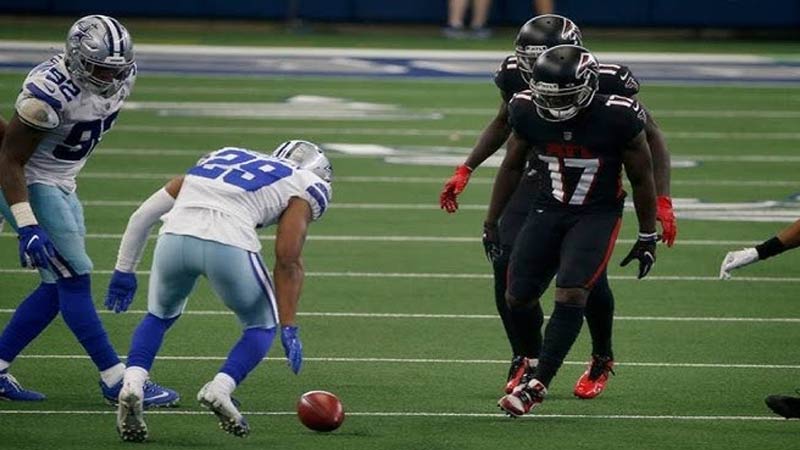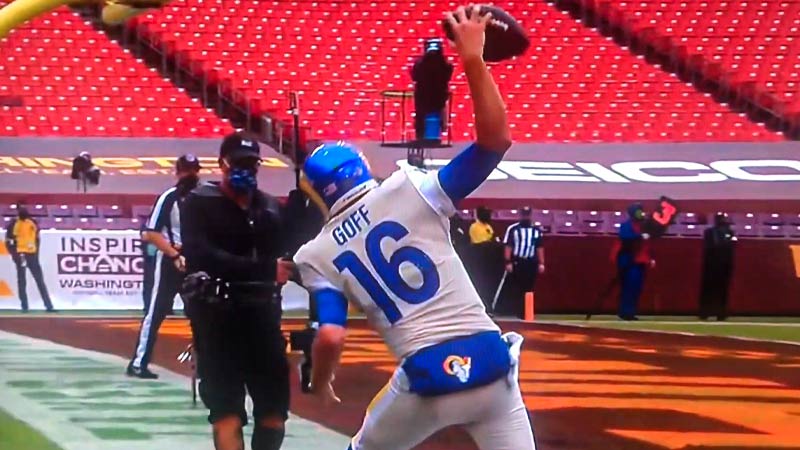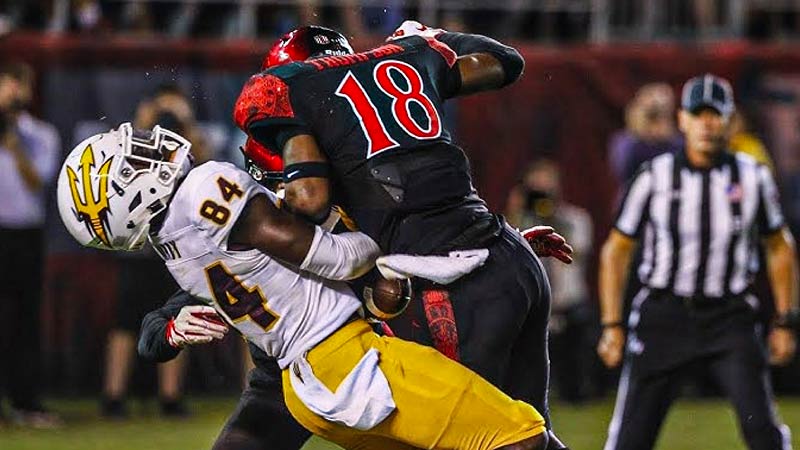Spiking the American football is a familiar sight on the gridiron, an exhilarating burst of celebration after a successful touchdown or game-changing play.
Yet, beneath the surface of this seemingly innocuous act lies a set of rules and guidelines that determine whether this celebratory gesture turns into a costly penalty.
While spiking the football is generally permitted and even encouraged to a degree in American football, there are critical considerations.
Players must ensure their actions remain within the boundaries of sportsmanship, safety, and respect for the game.
This introduction sets the stage for a deeper exploration of the rules governing the practice of spiking the American football and the potential penalties associated with it.
What Is Penalty in Football?
In football, a penalty is a punitive action imposed by the game’s officials to penalize a team or player for violating the established rules and regulations.
Penalties are used to maintain fairness, sportsmanship, and the integrity of the game. When a violation occurs, the referee or other officials signal a penalty by throwing a yellow flag onto the field.
Penalties can take various forms, including yardage penalties, loss of downs, or the awarding of a first down to the opposing team.
Yardage penalties involve moving the ball forward or backward by a specified number of yards, depending on the nature and severity of the infraction.
Common penalties include holding, pass interference, offside, and unsportsmanlike conduct.
The purpose of penalties is to deter rule-breaking, level the playing field, and ensure that the game is played within the established boundaries.
Teams must strive to minimize penalties and adhere to the rules to maintain their competitive edge.
What Does Spike the Ball Mean in Football?

In football, “spiking the ball” refers to an action where a player intentionally throws the football forcefully onto the ground immediately after a play, typically following a touchdown or a big gain.
This is often done as a celebratory gesture to express excitement or enthusiasm after a successful play.
The player typically spikes the ball to the ground with force, causing it to bounce back up, and then retrieves it.
Spike the ball is not considered a penalty in most cases, as it is a common and accepted form of celebration.
However, there are rules and guidelines associated with spiking the ball. It must be done within reason and should not be excessively prolonged or directed at opponents in a taunting or disrespectful manner.
Excessive or unsportsmanlike spiking can result in a penalty for unsportsmanlike conduct.
Overall, spiking the ball is a way for players to showcase their emotions and celebrate a positive outcome during a football game, and it is a widely recognized and accepted practice in the sport.
Is Spiking the American Football a Penalty? NFL
Spiking American football is a common celebratory act that occurs after a player scores a touchdown or makes a significant play during a game.
While spiking the ball is a popular way for players to express their excitement and emotion, it can result in a penalty if not done within the rules set by the National Football League (NFL) or other governing bodies.
In the NFL, spiking the football is generally allowed, but there are specific rules that must be followed to avoid a penalty.
The key rule is that the spike must not be excessive, unsportsmanlike, or directed at an opponent.
Here are a few important points to consider:
Excessive Celebration
Excessive celebration penalties can be subjective and often depend on the discretion of the officials. While the NFL allows players to celebrate their achievements, there is a fine line between expressing joy and drawing excessive attention to oneself.
For example, choreographed celebrations or those that involve multiple players are generally discouraged. Players should be mindful of this rule and avoid drawing unnecessary attention that could lead to a penalty.
Delay of Game
After scoring a touchdown, the clock continues to run until the ball is spotted for the extra point attempt or two-point conversion.
Spiking the ball is a common way to stop the clock briefly to allow the team to set up for the extra point. However, players must ensure that this action does not consume too much time.
Safety Considerations
Player safety is paramount in football. When spiking the ball, players should be aware of their surroundings to avoid any accidental collisions or injuries.
This means that the spike should be controlled and directed toward the ground, not wildly thrown into the air or toward other players.
A high-velocity spike could potentially harm someone nearby, leading to safety concerns and a possible penalty.
Taunting
Taunting opponents is strictly prohibited in football. While celebrating is encouraged, it should never be done at the expense of an opponent’s dignity.
Spiking the ball in a way that is intended to mock or provoke an opponent, such as directing it toward them or engaging in verbal taunts during the celebration, is considered unsportsmanlike conduct.
Players should celebrate their achievements but avoid engaging in actions that can incite conflicts or degrade the sportsmanship of the game.
Rules for Spiking a Football

Spiking a football in American football is a common celebratory act, especially after scoring a touchdown.
While the rules for spiking are relatively straightforward, it’s essential to understand and follow them to avoid penalties and maintain the integrity of the game.
Here are the key rules for spiking a football:
Scoring Play
Spiking the football is typically done after a scoring play, such as a touchdown or field goal. It is a way for the player or team to celebrate their success.
Immediate Action
When a player wants to spike the football, they should do so promptly. Delaying the spike excessively or engaging in prolonged celebrations can result in a penalty for unsportsmanlike conduct or delay of game.
Controlled Spike
The spike itself should be controlled and not thrown violently or recklessly. The player should firmly and decisively throw the ball into the ground, typically aiming for a downward angle to prevent it from bouncing dangerously. An overly forceful or aggressive spike that endangers others can lead to penalties.
Safety Concerns
Players must be aware of their surroundings when spiking the ball. They should ensure that no one, including teammates, opponents, officials, or spectators, is in the immediate vicinity that could be harmed by the spiked ball. Safety is paramount.
Unsportsmanlike Behavior
Spiking the football should not be used as a means of taunting or provoking opponents. Directing the spike toward an opponent, using it to incite conflicts, or engaging in any unsportsmanlike conduct during the celebration can lead to penalties.
Respect for the Game
While celebrations are allowed and even encouraged to some extent, players should remember the importance of sportsmanship and respect for the game.
Excessive, disrespectful, or over-the-top celebrations can detract from the spirit of fair competition and teamwork.
Penalty Consequences
Violating the rules for spiking the football, such as excessive celebration or unsportsmanlike behavior, can result in penalties assessed against the team.
These penalties can vary in severity, including 15-yard penalties for unsportsmanlike conduct, which can impact field position and potentially the outcome of the game.
Spiking the Football After Touchdown

Spiking the football after a touchdown is a common and widely accepted celebratory act in American football.
It’s a way for players to express their excitement and enthusiasm after successfully scoring six points for their team.
Here are the specific rules and guidelines for spiking the football after a touchdown:
Timing
Spiking the football after a touchdown is typically done immediately following the successful scoring play.
It’s a spontaneous celebration that often occurs in the end zone right after the player crosses the goal line with the football.
Controlled Spike
The spike should be a controlled and deliberate action. Players usually throw the football forcefully into the ground, aiming for a downward angle to prevent it from bouncing dangerously or unpredictably. It’s not a wild or aggressive action; rather, it’s a symbolic expression of joy.
No Delay of Game
Spiking the football should not cause a delay of game. After the touchdown, there is a brief window of time for the extra point or two-point conversion attempt.
Spiking the ball should not consume excessive time, and the team should be ready to line up for the extra point without delay.
Respectful Gesture
Spiking the football after a touchdown is seen as a respectful way to celebrate a successful play. It is not intended to taunt opponents, and it should not be directed at them in a provocative manner. Players should avoid any unsportsmanlike conduct during the celebration.
Safety Awareness
Players should always be aware of their surroundings when spiking the football. There should be no risk of the ball accidentally hitting an official, teammate, opponent, or spectator. Safety is a paramount consideration in all aspects of the game.
Penalty Consequences
If the spike is deemed excessive, disrespectful, or unsportsmanlike, it can result in a penalty for unsportsmanlike conduct.
This penalty usually results in a 15-yard assessment on the ensuing kickoff or the start of the opponent’s possession, depending on the timing of the infraction.
FAQS
Can spiking the football lead to an ejection?
In some cases, repeated unsportsmanlike conduct, including excessive or disrespectful spiking, can lead to a player’s ejection from the game. Ejections are typically reserved for severe violations of sportsmanship.
Are there different rules for spiking in college football?
Yes, college football may have slightly different rules and interpretations of unsportsmanlike conduct compared to the NFL.
What if a player spikes the ball in celebration during a crucial game moment, like the Super Bowl?
The rules governing spiking do not change based on the significance of the game.
In high-stakes situations, players are expected to maintain composure and celebrate responsibly to avoid penalties.
Can a coach be penalized for a player’s excessive spiking?
Coaches are responsible for ensuring their players follow the rules.
If a coach encourages or tolerates excessive spiking or unsportsmanlike behavior, they can be penalized with an unsportsmanlike conduct penalty as well.
Are there any circumstances where spiking is explicitly prohibited?
Generally, spiking is allowed after touchdowns.
However, if a touchdown is nullified due to a penalty or if a player fumbles before crossing the goal line, spiking may not be permitted in those situations, as the play is not officially considered a touchdown.
Wrap Up
The act of spiking American football, while a cherished celebration in the world of football, is subject to a set of essential rules and considerations.
This exuberant display of triumph is generally embraced, yet it must be executed within the confines of sportsmanship, safety, and respect for the game.
Players must wield their excitement with restraint and consciousness of their surroundings to prevent excessive or unsportsmanlike spiking, which can result in penalties.
Understanding the nuanced rules governing this act is crucial to preserving the integrity of the game and ensuring that this iconic celebration remains an emblem of joy and teamwork rather than a costly transgression on the field.







